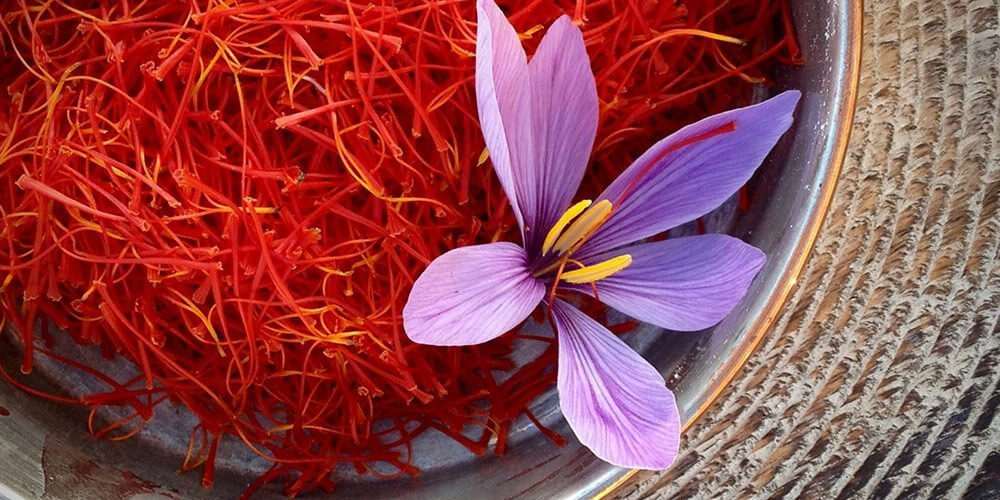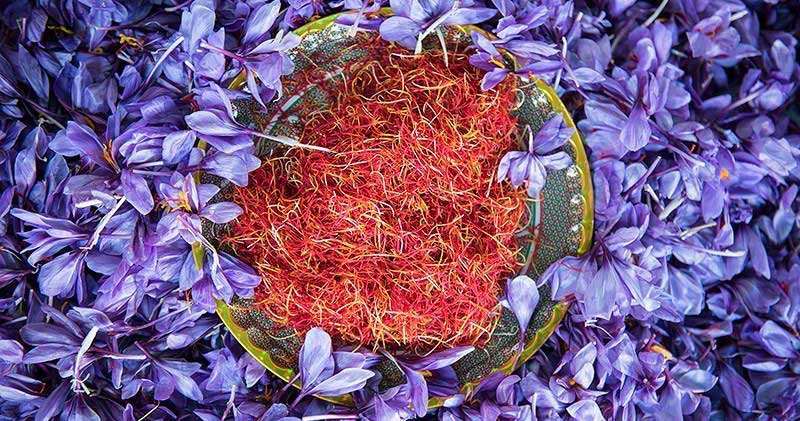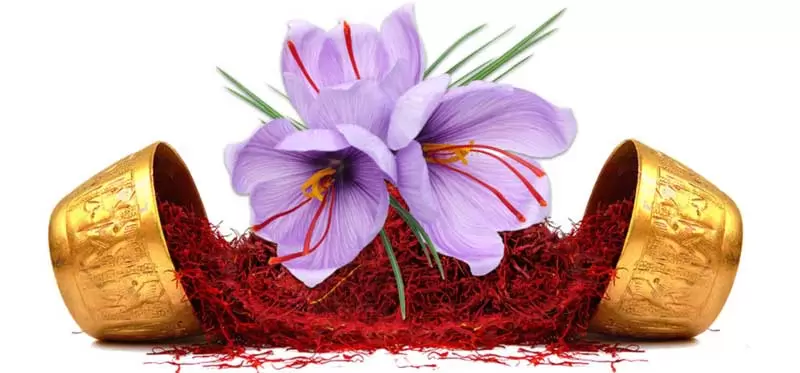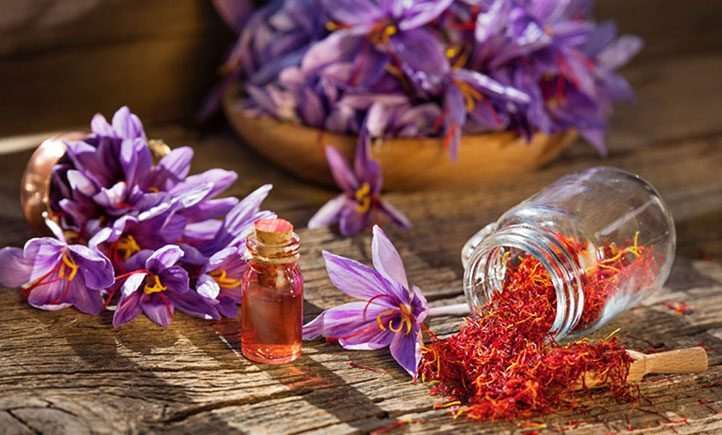Saffron

Saffron is a perennial plant that has a bulb. This bulb has a brownish sheath. The plant grows in southwestern Asia, southern Spain, and southern Europe. It has a stem and six purple petals and three red stigmas. The part of the saffron plant that is used is the orange stigma of its flower. Saffron stigma contains fat, minerals, and mucilage. Saffron propagation is exclusively through its underground bulb (corm). The fragrance and smell of saffron are due to the presence of a colorless tropane essence and an oxygenated compound accompanied by cineole called safranal. The taste of saffron is related to the bitter heteroside picrocrocin. The colorfulness of saffron is related to the presence of a substance called crocin.
Saffron is a valuable food substance that is obtained in small quantities from the saffron plant. In fact, about 5 kilograms of saffron flowers are obtained from every 100 to 200 thousand saffron plants. The weight of 5 kilograms of fresh saffron reduces to one kilogram after drying.
Nutritional value of saffron
Saffron is a spice and food colorant. Saffron helps reduce fat and cholesterol in the blood. Saffron is calming, appetite-stimulating, antispasmodic, preventive of heart disease and cancer, memory-enhancing, and blood pressure-reducing. The saffron plant is used in the treatment of asthma, skin diseases, eye diseases, urinary tract infections, jaundice, menstrual induction, relieving stomach bloating, treating stomach pain, and treating anemia.
Saffron aids in digestion and is a stomach strengthener. It is also used as a pain reliever, especially for gum pain.
Relieving abdominal pain
Since ancient times, due to the properties of saffron for women, saffron brew has been effective for moderate to severe abdominal pain and upper abdomen. This plant was used to regulate the menstrual cycle and reduce bleeding during this period. Also, another property of saffron for women is to reduce menstrual pain and regulate the menstrual cycle.
Saffron, an anti-depressant plant
The consumption of saffron is effective in preventing depression. Modern research has also concluded that saffron has antidepressant properties. This is while traditional fever has attributed joy and laughter to saffron. According to the results of these studies, it is recommended to use saffron in food and drink at least one cup of saffron tea for nerve extension. Saffron is a concentration enhancer and is effective in preventing Alzheimer’s and Parkinson’s. Saffron is effective in treating nerve pain and insomnia.
Heart health with saffron tea
According to conducted studies, it has been reported that saffron tea prevents the accumulation of cholesterol in the arteries, thereby preventing heart diseases.

Saffron, a preventive agent against vision loss in old age
Based on research from an Italian university center, saffron is effective in regulating the function of vision cells. It protects vision cells against damage, prevents the progression of eye diseases, and revives damaged eye cells. Saffron is effective in treating retinal yellow spot disorders that occur in old age. Consuming saffron in the diet prevents the progression of genetic eye diseases. Therefore, a balanced consumption of it is recommended for the elderly and people with eye diseases.
Saffron and its health benefits
Vitamin C, or ascorbic acid, is extraordinarily vital and important for human health. It stimulates the human body’s immune and defense system to produce white blood cells, which are the body’s frontline defense against diseases and microbial and viral agents. It is also essential for the production of collagen. Collagen is necessary for cellular production in the body for wound and injury repair, muscle growth, blood vessel repair, and tissue production.
The anti-cancer properties of saffron
Saffron has anti-cancer properties and acts as an anti-tumor drug and a scavenger of free radicals. Based on medical research, it has been proven that the antioxidants present in saffron have anti-cancer properties. According to the results of this study, it seems that the use of saffron prevents the occurrence of cancerous genetic sequences and has a significant effect on the repair of damaged DNA molecules.
Blood pressure reducer
In recent years, stressful and sedentary urban life, along with poor dietary habits, have led to an increasing number of people suffering from high blood pressure. However, since one of the properties of saffron for both women and men is to reduce blood pressure, by adding some of this colorful plant to your meals, you can somewhat prevent the increase in your and your family members’ blood pressure.

Saffron is an expectorant
The properties of saffron for the uterus and easy childbirth
In a study presented at the Third Millennium Herbal Medicine Symposium on the treatment of difficult childbirth with saffron, it was found that eating saffron during pregnancy prepares a person for easy childbirth. According to this research, consuming saffron during the critical period of pregnancy, which is the first three months when organs are formed, can harm the fetus. Consuming saffron in the first three months of pregnancy increases the hormone prostaglandin in the uterus and has a direct stimulating effect on the smooth muscles of the uterus, resulting in the possibility of a miscarriage. However, balanced consumption of it after the first three months of pregnancy is beneficial and prepares the mother for easy childbirth. Saffron causes elasticity in the uterine tissues and makes childbirth easier.
Saffron that is consumed after the first three months of pregnancy has its effect a few hours before childbirth with the onset of pain and the reception of pain receptors and the production of the hormone prostaglandin, which during childbirth causes the muscles of the uterine wall to contract and has a direct stimulating effect on the smooth muscles of the uterus and the relaxing effect of the cervix. Therefore, with the correct consumption of saffron, the amount of prostaglandin in the uterus at the time of the baby’s birth is increased and prevents difficult childbirth.
Other properties of saffron for women and men
In addition to the mentioned cases, saffron is beneficial in the treatment of asthma and respiratory diseases, nervous attacks, insomnia, heartburn, dry skin, and many other diseases.
Although saffron is always high, it is cheaper than the cost of a doctor and medicine and treatment! Given the wide range of benefits of saffron for women and men, we strongly recommend adding this fragrant spice to all foods and hope you always have a healthy and energetic body.

Therapeutic properties of saffron
One of its therapeutic properties is its analgesic effect.
It strengthens sexual powers.
Add saffron to warm milk and drink it before sleep to have a comfortable sleep.
It is menstruation-inducing.
Among the properties of saffron is its help in strengthening memory and learning.
Saffron dissolved in milk eliminates dryness and itching of the skin.
Since it helps blood circulation, it treats kidney, bladder, and liver disorders, and cleanses the kidneys and bladder.
The carotenoid present in it prevents the occurrence of skin tumors and relieves arthritis pain.
Red gold is blood-forming and facilitates blood circulation.
One of the properties of saffron is reducing blood fat.
Consumption of saffron eliminates postpartum bleeding.
Another benefit of it is very effective in reducing blood cholesterol.
In addition to purifying the blood, another property of saffron is its anti-inflammatory property.
Massaging the gums with saffron water eliminates inflammation and mouth ulcers.
Recent studies show that saffron has anti-cancer properties.
It combats anxiety and depression.
The benefits of saffron are its calming and sleep-inducing properties.
Another medicinal property of saffron is relieving stomach bloating and treating stomach gas.
Topical use of saffron heals wounds and burns faster.
Another property of saffron is effective in treating convulsive conditions and toothache.
Saffron is effective in treating asthma.
It relieves cough and has a beneficial effect on the treatment of bronchitis.
This plant is diuretic.
Drinking saffron tea aids digestion.
One of the most important benefits and medicinal properties of saffron is its invigorating effect.
The appropriate and permissible amount of saffron consumption per month
Consuming three grams of saffron per person per month is very healthy and beneficial, and consuming more than 5 grams of it per person per month is harmful. However, consuming 5 grams of saffron in one meal can lead to death.
Saffron storage
Saffron should be kept away from light and moisture. Store saffron in sealed glass or metal containers. Note that saffron essence is evaporable, so close the lid of the saffron container. If the lid of the saffron container remains open, its medicinal effects and quality will decrease.
Uses of Saffron
Saffron gives a special aroma and color to foodstuffs, and for this reason, saffron is used in food industries such as sausage making, in confectionery such as making cake powders, in pharmaceuticals such as antidepressants, in textiles such as dyeing silk fabrics, in the production of alcoholic and non-alcoholic beverages as a natural flavoring, and in dairy industries and so on.
For ordering various medicinal plants including dried herbs, essences, infusions, and herbal oils, contact Tata Trading Company and ask for our high-quality and reasonably priced products from our trading group.

